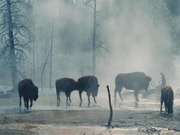Native Healing
Native American / Native Hawaiian Medicine
Native medicines and healing methods have been proven effective through the generations. The medicines and healing ways of Native Americans and Native Hawaiians shared on this page will be updated as time allows, so check back frequently.
Native Medicine of the Plains
Ha Pejuta Salve(Traditional Medicine) - Lakhota
Ingredients
Wild Bergamont, Arnica, Calendula, Lavendar, Tree Oil, Garlic, Olive and Vitamin E Oils, and local beeswax.
This salve works fast and effectively on muscle aches, joints and tension. It also helps heal sprains, bruising, and swelling. Rubbed on temples and back of neck for headaches, this salve will stimulate circulation and healing.
Native American Medicine of the Northeast
Bayberry(Myrica pensylvanica L.)
This plant has several medicinal uses. The powdered root was used to treat arthritic and rheumatic pain (For this purpose, the root material may have been boiled in water and the liquid used as a bathing solution.), as were the leaves when used in poultice form. The leaves and dried roots steeped in water, were taken as a tea to treat mouth infections. In this regard, the tea was used regularly as a mouth wash.
Birch, Yellow (Betula allegheniensis Britt.)
The inner bark of the tree was used to relieve indigestion and stomach cramps. The bark was chewed or steeped in water, and taken as a tea. The inner bark is supposed to be nourishing and can be chewed when one is in need of extra energy
Bunchberry (Cornus canadensis L.)
The plant was used to treat kidney ailments. It was given to children in tea form to prevent bed-wetting. Bunchberry leaves were applied to wounds to stop bleeding and to promote healing.
Labrador Tea(Ledum groenlandicum, Oeder)
The leaves of this plant were used as a tea by the Mikmaq. It was known as a general tonic tea and often used in the spring of the year (spring tonic). As well, they used the tea for a variety of kidney ailments, including kidney stones. It was also used in kinnickinnick mixtures in some areas of North America.
Meadow Beauty(Rhexia virginica L.)
This plant is found growing in wet places in some areas of the Maritime provinces of Canada (for example, along lake shores). The Mi'kmaq may have used the meadow beauty as a wash to clean and clear the throat. The leaves, flowers, and stem of the plant were steeped in water to produce a sour drink which was used as a gargle medicine.
Plantain (Plantago major L.)
The Mi'kmaq used plantain leaves to draw poison from wounds, and to heal them. The leaves were crushed or bruised and applied in poultice form. Also, plantain leaves were steeped in water, and the liquid taken internally as a general stomach medicine (for example, to treat stomach ulcers).
Sweet Fern (Comptonia peregrina L. Coult.)
The leaves of sweet fern make a pleasant tea. Gently steep a few leaves to a cup of water. The Mi'kmaq used the leaves to treat poison ivy rash. The leaves were steeped or boiled in water, and the liquid used to bath the poison ivy rash. The treatment should be repeated on a regular basis.
Teaberry(Gaultheria procumbens L.)
The Mi'kmaq probably had many uses for the teaberry plant. It is known as a heart attack preventive medicine and was also given to people recovering from that affliction. It has also been used by people with blood cloting problems, and by those who have had strokes. The plant is supposed to thin and regulate the blood, much as aspirin does, thus preventing the formation of blood clots. The entire plant was steeped in water and the liquid used as a tea. Probably a more effective way to prepare the medicine is to partly (about 1/4) fill a bottle or jar with the leaves. Then fill the jar with boiling water, cover, and allow it to stand in a warm place for a couple of days. It makes a wonderful wintergreen tea.
It is probably also good as a massage liquid for sore aching muscles and joints, although I haven't tryed this personally. (Note: To find the proper dosage for teaberry, one should consult herbal books. This would vary depending on how it is made, how long it is allowed to steep, or whether the covered jar method is used, in which case the medicine would be stronger and the dosage less than if steeped for ten or fifteen minutes.)



